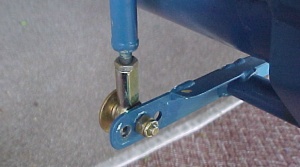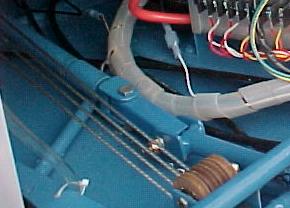Heavy Aileron Fix
Kolbs tend to have very light elevator and rudder
pressure, and comparatively heavier ailerons. Some have resorted
to changing the cord of the ailerons to reduce the stick pressure,
and that is certainly an option. However, it appears to be simpler
to change the bellcrank ratio and adjust the mechanical advantage
so that you have less aileron movement for a given amount of stick
throw. We have both observed that while in flight, the FSII ailerons
tend to want to stay in trail due to air loads, even with large
control throws. Even if you use both hands to displace the control
stick fully to either side, watching the aileron reveals that
it actually moves up or down very little. What happens is that
the aileron tube torques and twists, resulting in minimal aileron
deflection due to air resistance. So I drilled two extra holes
on either side of the bellcrank, each 1/2" apart on center,
to the inside of the standard hole. Our flight tests show that
with the aileron pushrod in the innermost bellcrank hole, control
forces are extremely light, but require a large amount of stick
throw to get a good control response. Moving the aileron pushrod
to the original outermost bellcrank hole gives about 15-20% more
control response, but doubles the amount of effort required. So
we now have the pushrods in the middle hole, which works very
well.
 The position of the innermost hole is determined
by making sure the push rods will not contact the side of the
fuselage or the large through bolt that joins the boom tube to
the cage. It could be that the pushrods happen to line up right
with the through bolt, if so, you can move the bell crank rod
assembly toward the tail of the aircraft by making a longer universal
joint, pictured here.
The position of the innermost hole is determined
by making sure the push rods will not contact the side of the
fuselage or the large through bolt that joins the boom tube to
the cage. It could be that the pushrods happen to line up right
with the through bolt, if so, you can move the bell crank rod
assembly toward the tail of the aircraft by making a longer universal
joint, pictured here.
 Instead of using the standard short u-joint between
the control linkage and the bell crank rod, we made one about
twice as long and substituted it. Works fine and moves the aileron
bell crank back to where the pushrods will clear the through bolt
that goes through the fuselage and the boom tube.
Instead of using the standard short u-joint between
the control linkage and the bell crank rod, we made one about
twice as long and substituted it. Works fine and moves the aileron
bell crank back to where the pushrods will clear the through bolt
that goes through the fuselage and the boom tube.